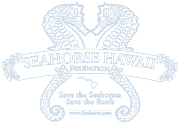Ocean Rider Seahorse Farm and Tours | Kona Hawaii › Forums › Seahorse Life and Care › New tank › Re:New tank
Dear Nigel:
Seasons greetings, sir! A more spacious 30-gallon aquarium with PC lighting is a very nice upgrade and should make a fine home for your seahorses. I would be happy to discuss some methods that can help speed up the cycling process for your new aquarium so you can liberate the seahorses from their cramped temporary holding tank as soon as possible.
A few things that are known to accelerate the nitrogen cycle and establish the biofiltration more quickly are to increase the aeration/oxygenation in the new tank, raise the temperature of the water to allow the population of nitrifying bacteria to grow faster, add live rock and live sand to the aquarium, and to feed the biofilter with ammonia you add to the water drop by drop.
The porous interior of pre-cured live rock houses a considerable population of both aerobic nitrifying bacteria and anaerobic denitrifying bacteria, and this can provide the aquarium with some limited instant biological filtration ability and therefore help accelerate the cycling process. Live sand likewise contains both Nitrobacter and Nitrosomonas nitrifying bacteria, which helps speed up the nitrogen cycle by providing the necessary "seed" bacteria to kickstart the whole cycling process. But the use of live rock and live sand, or pre-aged saltwater, normally does not eliminate the need to cycle your aquarium entirely. You will still need to provide a source of ammonia to feed the beneficial bacteria and build up a sufficient population of the "good guys" in order to handle all the wastes produced by your seahorses, and you will have to monitor the aquarium closely while it cycles in order to determine when the process is complete.
Besides using live rock on live sand, you can further accelerate the cycling process by increasing the aeration and the temperature in the aquarium while it is cycling. The beneficial nitrifying bacteria (Nitrosomonas and Nitrobacter sp.) that convert ammonia to nitrite and nitrite to nitrate are all aerobic or oxygen-loving microbes, so their population will increase faster if there is a high level of dissolved oxygen in the aquarium. Adding an airstone to provide better surface agitation and promote efficient aeration and oxygenation while your tank cycles should be helpful.
In addition, I would raise the temperature in your aquarium to around 80°F while it cycles. Bacteria multiply faster at warmer temperatures, so raising the water temperature should help stimulate faster growth of the beneficial nitrifying bacteria as well. (Don’t forget to reduce the aquarium temperature back to normal once it’s finished cycling so that it’s optimal for your seahorses.)
Finally, you might consider feeding the aquarium directly with ammonia drop by drop, as described below. This method of feeding the biofilter while the aquarium cycles has a couple of worthwhile advantages. First of all, the amount of ammonia you add daily is far greater than that the amount of ammonia hardy damsels or mollies or even a decaying shrimp can produce nature’s way as waste products. The excess ammonia means the bacterial colonies can grow faster and produce much larger populations of Nitrosomonas and Nitrobacter bacteria by the time the cycling process is complete (Cow, Jan. 1999). The result is that your tank cycles faster, typically in 10-21 days as opposed to 4-6 weeks for more conventional cycling methods, and the tank can ordinarily be stocked at capacity once the cycle is completed (Cow, Jan. 1999).
To cycle your tank this way, simply add ammonia drop by drop, keeping track of how many drops you’ve added, until it produces a reading of ~5 ppm on your test kit (Cow, Jan. 1999). Then continue to add exactly that many drops of ammonia each day thereafter until you begin to see detectable levels of nitrite. Then once nitrite readings begin to appear on your test kits, cut back the amount of ammonia you add to 1/2 the original amount, and continue to add a half dose of ammonia each day until the cycle has finished and you stock the aquarium (Cow, Jan. 1999).
It is important to use your test kits every day or two when cycling your tank to monitor the progress of the process. One benefit of fishless cycling method is that it produces an immediate ammonia spike, which accelerates the cycling process accordingly (Cow, Jan. 1999). So at first you will see a rapid rise in ammonia levels with no detectable nitrite or nitrate. Then, as Nitrosomonas bacteria begin converting ammonia to nitrite, the ammonia levels will fall and nitrite readings will steadily rise. Nitrite levels will peak as the ammonia drops to zero. Next, Nitrobacter will begin converting the nitrite to nitrate, and your nitrite readings will fall as the level of nitrate rises. Finally, after the nitrites also read zero, you are ready to stock your tank. At this point, your ammonia and nitrite levels should both be zero, nitrates will be building up, and algae will usually begin to grow. This will tell you that your biofilter is active and functioning properly, and that you can now safely begin stocking the tank (Fenner, 2003b). It generally takes anywhere from 10 days to 3 weeks to cycle a tank this way from scratch using the fishless cycling technique (Cow, 1999).
When cycling your tank with this method, it is advisable to perform large water changes (70%-100%) before adding any specimens to the tank in order to lower the elevated nitrate levels it produces and correct the pH (Cow, 1999). Otherwise, it can be difficult to bring the nitrate down to manageable levels again after the tank is stocked. Ammonia is a powerful base, so adding ammonia changes the pH of the water substantially, making it more alkaline (Warland, 2003). A large water change will reduce nitrite levels and lower the pH back to normal after the tank has cycled.
When changing the water, avoid using dechlorinators that also sequester ammonia, the so-called ammonia quellers, since we are relying on high ammonia levels to feed the bacteria colonies. When performing water changes during a fishless cycle, stick with simple chlorine neutralizers that don’t affect ammonia levels (Cow, 1999).
Not just any ammonia will do when cycling the tank this way. The ammonia used for this purpose should be free of surfactants, perfumes, and colorants (Cow, 1999). ACS grade ammonium hydroxide is best but may be hard to find. Pure or clear ammonia will do nicely and the best places to get it usually hardware stores or discount grocery stores. Many times it’s the off-brands or little-known, no-frills generic brands that work best (Cow, Jan. 1999).
When you find a likely candidate, be sure to check the ingredients on the bottle of ammonia. The good stuff will simply say Clear Ammonia (or Pure Ammonia or 100% Ammonia, or Pure Ammonium Hydroxide), and list no additives (surfactants, coloring agents, perfumes, etc.; Cow, 1999). If the bottle does not list the ingredients or lists added ingredients like those specified above, pass it by and take your search elsewhere. When in doubt, administer the shake test. Shake the bottle vigorously — ammonia that contains surfactants will foam up, but the good stuff suitable for fishless cycling will not (Cow, Jan. 1999).
When cycling the tank this way, it’s important to remember that the high levels of ammonia involved are toxic to all fish and invertebrates, so you cannot use ammonia to establish the biofilter if there are any inhabitants present in the aquarium (Warland, 2003). This includes live rock. The ammonia will kill off bristleworms, crabs and other crustaceans, tubeworms, snails and mollusks, and much of the desirable life on the rocks will be lost during the cycling process. If you want use ammonia to cycle an aquarium that will have live rock, finish cycling the tank first and only then add the live rock.
In short, Nigel, if you increase the aeration/oxygenation in your new 30-gallon aquarium, raise the water temperature, add live sand, and feed the Nitrosomonas bacteria with lots of ammonia, and then add pre-cured live rock, the cycling process should be accelerated considerably, and you’re new tank should be ready for your seahorses before you know it.
In the meantime, I agree it would be a good idea to set up a refugium in your or established 55-gallon aquarium and transfer the seahorses there while your new seahorse tank furnishes cycling. The seahorses will benefit from much better water quality in the 55 gallon setup, and the refugium will protect them from the lionfish and eel and damselfish, all of which can indeed be tough on seahorses.
Best of luck with your new 30-gallon seahorse setup, Nigel!
Happy Trails & Happy Holidays!
Pete Giwojna




